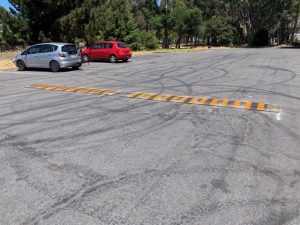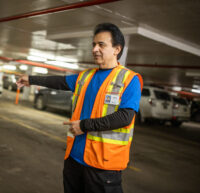By Larry Barnett —
The City of Sonoma is reviewing the most recent in a series of Plaza parking studies conducted over the past three decades. Like all past studies, this one notes that Plaza parking spaces are limited in number, and that employees of businesses around the Plaza account for roughly 50% of the parked cars.
The study recommends a variety of approaches to address that problem, increased turnover of vehicle parking while maintaining a positive economic environment downtown. Other than the use of newer technology to enforce parking time limits, most of the ideas have been included in past studies. Notably, few of any recommendations from past studies have ever been implemented, particularly paid parking.

State Parks, which owns the large Casa Grande Parking Lot behind the Barracks, has informed the city that it will be converting that lot from free to paid parking in 2023. How much will be charged for parking is unknown at this time, but charging at all will fundamentally alter the parking ecology of downtown; encouraging free parking in Casa Grande has long been at the core of the city’s parking strategy, and if it is converted to paid parking, it will likely force the city to begin to charge for parking as well.
Generally, parking studies utilize a reductionist approach to analysis and recommended solutions, breaking down their examination by dividing the various components at play, namely the number of public and private parking spaces available, paid parking technologies, peak hour analysis, the effects of special events, needs of residents, and impacts of tourism. In this way, however, a laundry list of options is produced that addresses parts rather than the whole. It’s a common approach, but like any reductionist methodology, addresses each component separately, which tends to obscure the big picture.
A living systems approach, on the other hand, is holistic, looks at how the Plaza functions as an organic whole, its purpose in the city body and the role that parking plays, including its particular purpose. Evaluated as a living system, where the Plaza cannot be separated from the city body, Plaza parking can be assessed more coherently.
This analogy is already how we relate to such issues. For example, roadways are referred to as circulation; they are the blood vessels of the city body; some are even called arterials, and like arteries, they can get clogged and impede the flow of vehicles. We talk about imposing road “diets” and the reduction of lanes on Broadway is an example. In this analogy, vehicles are blood cells, bringing nutrients and transporting calories to the body of the city. Calories, in this case, are goods and money, which the businesses need to survive.
The downtown Plaza is the heart of the city, the organ that collects and pumps blood through the community. Parking, in this case, is the mechanism of fixed receptor sites in organs that provide a way for the delivery of calories and nutrients like oxygen to living cells, which in this analogy are the businesses that perform the work of the city body’s economy. Lifelike, everything’s connected, even the creation and disposal of waste, and even small changes affect the system as a whole.
Living systems are in a constant state of dynamic instability, balancing energy input with workload. To use another analogy, although water droplets running in a creek are always changing, the creek itself can remain stable; optimally, a kind of equilibrium can be established, a dynamic kinetic stability where input and output are in relative balance. So it is with The Plaza; if the living system of the city body gets out-of-whack, discomfort arises.
The physical form of The Plaza has been essentially the same for over 150 years, and that is not going to change unless it undergoes radical surgery, which it will not. To continue the analogy, The Plaza has a natural carrying capacity and can accommodate only so much blood flow. Attempts to force too much blood into the heart of The Plaza affects its functioning; accordingly, the appetites of the body must have constraints. And as in healing the living body, the cure includes the discipline of restraint.
Pumping an ever greater number of people – their cars, delivery trucks, and money – into the Plaza is gluttonous and unhealthy. Expanding the parking opportunities around The Plaza will not solve systemic overload, it further overwhelms the circulation system and taxes the ability of The Plaza to function properly as a public gathering place and economic center. It’s not rocket science, it’s more like biology, the way living systems work. Balance brings health. The natural carrying capacity of The Plaza is telling us what our limits are; we don’t need a doctor or yet another expensive study to tell us when enough is enough.
Larry Barnett is Vice-Chair of Sonoma’s Planning Commission and a member of the Sun Editorial Board.






Be First to Comment